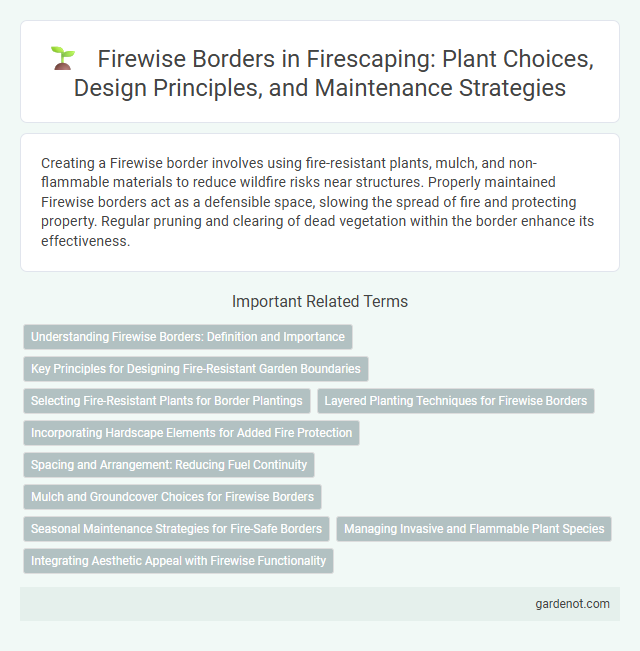Creating a Firewise border involves using fire-resistant plants, mulch, and non-flammable materials to reduce wildfire risks near structures. Properly maintained Firewise borders act as a defensible space, slowing the spread of fire and protecting property. Regular pruning and clearing of dead vegetation within the border enhance its effectiveness.
Understanding Firewise Borders: Definition and Importance
Firewise borders are strategically designed perimeters around properties that use fire-resistant plants, non-combustible materials, and appropriate spacing to reduce wildfire risk. These borders act as critical fuel breaks, slowing or stopping the spread of flames and protecting homes from intense heat and embers. Understanding Firewise borders involves recognizing their role in creating defensible space and enhancing overall wildfire resilience.
Key Principles for Designing Fire-Resistant Garden Boundaries
Firewise borders incorporate fire-resistant plants, non-flammable mulch, and strategic spacing to minimize fuel continuity and reduce fire spread. Key principles emphasize selecting native, drought-tolerant species that maintain high moisture content and installing hardscape elements such as gravel or stone to create effective firebreaks. Proper maintenance, including regular pruning and debris removal, ensures the garden boundary sustains its fire-resistant properties over time.
Selecting Fire-Resistant Plants for Border Plantings
Selecting fire-resistant plants for Firewise border plantings reduces wildfire risk by incorporating species with low flammability, high moisture content, and fire-retardant oils. Plants such as manzanita, ceanothus, and succulents like sedum provide effective natural barriers due to their dense foliage and minimal resin content. Proper spacing and maintenance within the border further enhance fire resistance by limiting fuel continuity and reducing overall fire intensity near structures.
Layered Planting Techniques for Firewise Borders
Firewise borders utilize layered planting techniques that incorporate a mix of low-growing ground covers, medium-height shrubs, and taller trees to create defensible space against wildfires. These plant layers reduce fire intensity by breaking up fuel continuity and increasing moisture retention within the landscape. Strategic spacing and selection of fire-resistant species enhance the effectiveness of Firewise borders in minimizing fire spread near residential areas.
Incorporating Hardscape Elements for Added Fire Protection
Firewise borders that incorporate hardscape elements such as stone pathways, gravel beds, and brick edging create effective firebreaks by limiting combustible vegetation near structures. These non-flammable materials reduce fire intensity and slow the spread of flames, enhancing the defensible space around homes. Strategically designed hardscapes complement vegetation management to form a resilient barrier against wildfire threats.
Spacing and Arrangement: Reducing Fuel Continuity
Firewise borders are designed to reduce fuel continuity by strategically spacing and arranging plants to minimize fire spread. Proper spacing ensures that vegetation does not create a continuous path for flames, while arrangement prioritizes fire-resistant and low-flammability species. This deliberate layout disrupts fire flow, enhancing landscape resilience and protecting structures.
Mulch and Groundcover Choices for Firewise Borders
Selecting fire-resistant mulch and groundcovers is crucial for creating an effective Firewise border that minimizes wildfire risk. Inorganic mulches such as gravel or crushed stone do not ignite easily and help maintain soil moisture, while fire-resistant groundcovers like creeping sedum or ice plant provide green, low-flammability coverage that slows fire spread. Avoiding highly combustible materials such as pine needles or bark mulch enhances the fire safety of the landscape perimeter.
Seasonal Maintenance Strategies for Fire-Safe Borders
Firewise borders require seasonal maintenance strategies such as removing dead leaves, pruning low-hanging branches, and clearing combustible debris to reduce fire risk effectively. Regularly inspecting the border for invasive or highly flammable plants and replacing them with fire-resistant species enhances the fire safety of the perimeter. Implementing these seasonal practices supports the overall integrity of Firescaping and helps protect property from wildfires.
Managing Invasive and Flammable Plant Species
Firewise borders are essential for managing invasive and flammable plant species that increase wildfire risk near properties. Selecting fire-resistant native plants and removing dense invasive species like juniper and broom drastically reduces fuel loads and fire intensity. Regular maintenance, including pruning and debris removal, enhances the effectiveness of these landscapes in creating defensible spaces.
Integrating Aesthetic Appeal with Firewise Functionality
A Firewise border combines fire-resistant plants with visually appealing landscaping to create a protective barrier that reduces wildfire risk around homes. Incorporating drought-tolerant shrubs, gravel, and mulch not only enhances the aesthetic but also minimizes combustible materials near structures. Strategic placement of these elements ensures both safety and curb appeal, promoting resilience without sacrificing design.
Firewise border Infographic

 gardenot.com
gardenot.com